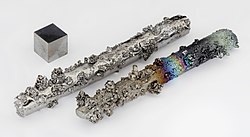Tungsten
A hard, rare metal under standard conditions when uncombined, tungsten is found naturally on Earth only in chemical compounds. It was identified as a new element in 1781, and first isolated as a metal in 1783. Its important ores include wolframite and scheelite. The free element is remarkable for its robustness, especially the fact that it has the highest melting point of all the non-alloyed metals and the second highest of all the elements after carbon. Also remarkable is its high density of 19.3 times that of water, comparable to that of uranium and gold, and much higher (about 1.7 times) than that of lead. Tungsten with minor amounts of impurities is often brittle and hard, making it difficult to work. However, very pure tungsten, though still hard, is more ductile, and can be cut with a hard-steel hacksaw.
Tungsten's many alloys have numerous applications, most notably in incandescent light bulb filaments, X-ray tubes (as both the filament and target), electrodes in TIG welding, and superalloys. Tungsten's hardness and high density give it military applications in penetrating projectiles. Tungsten compounds are most often used industrially as catalysts.
Tungsten is the only metal from the third transition series that is known to occur in biomolecules, where it is used in a few species of bacteria and archaea. It is the heaviest element known to be used by any living organism. Tungsten interferes with molybdenum and copper metabolism, and is somewhat toxic to animal life.
Occurrence
Tungsten is found in the minerals wolframite (iron-manganese tungstate, (Fe,Mn)WO4), scheelite (calcium tungstate, (CaWO4), ferberite (FeWO4) and hübnerite (MnWO4). China produced 51,000 tonnes of tungsten concentrate in 2009, which was 83% of the world output. In the prelude to WWII China's production of tungsten played a role as China could use this leverage to demand material assistance from the US government.[29] Most of the remaining production originated from Russia (2,500 t), Canada (1,964 t), Bolivia (1,023 t), Austria (900 t), Portugal (900 t), Thailand (600 t), Brazil (500 t), Peru (500 t) and Rwanda (500 t). Tungsten is also considered to be a conflict mineral due to the unethical mining practices observed in the Democratic Republic of the Congo.
| Symbol | W | |
| Atomic Number | 74 | |
| Atomic Weight | 183.84 | |
| Oxidation States | +6 | |
| Electronegativity, Pauling | 1.9 | |
| State at RT | solid | |
| Melting Point, K | 3680 | |
| Boiling Point, K | 5930 |
Appearance and Characteristics
Harmful effects:
Tungsten is considered to be of low toxicity.
Characteristics:
- Tungsten is a very hard, dense, silvery-white, lustrous metal that tarnishes in air, forming a protective oxide coating. In powder form tungsten is gray.
- The metal has the highest melting point of all metals, and at temperatures over 1650 oC also has the highest tensile strength. Pure tungsten is ductile, and tungsten wires, even of a very small diameter, have a very high tensile strength.
- Tungsten is highly resistant to corrosion. It forms tungstic acid (H2WO4), or wolframic acid from the hydrated oxide (WO3) and its salts are called tungstates, or wolframates.
- When present in compounds, tungsten exists mostly in the oxidation state VI.
- Tungsten is one of the five major refractory metals (metals with very high resistance to heat and wear).
Uses of Tungsten
- Tungsten and its alloys are widely used for filaments in older style (not energy saving) electric bulbs and electronic tubes.
- Tungsten is also used as the filament in halogen tungsten lamps. These lamps use halogens like bromine and iodine to prevent the tungsten filament from degrading and are therefore more energy efficient than standard incandescent light bulbs.
- High speed steel (which can cut material at higher speeds than carbon steel), contains up to 18% tungsten.
- Tungsten is used in heavy metal alloys because of its hardness and in high-temperature applications such as welding.
- Tungsten carbide (WC or W2C) is extremely hard and is used to make drills. It is also used for jewelry because of its hardness and wear resistance.
